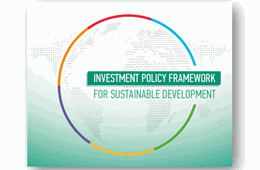Introduction
The 2015 Investment Policy Framework for Sustainable Development, officially launched at the Financing for Development Conference in Addis Ababa, provides guidance for policymakers in the evolution towards a New Generation of investment policies.
The Investment Policy Framework consists of an overarching set of Core Principles for Investment Policymaking that serve as design criteria for three sets of operational guidelines or action menus:
- guidelines for national investment policies,
- guidance for the design and use of international investment agreements (IIAs),
- an action menu for the promotion of investment in sectors related to the sustainable development goals.
In the three years since its original launch, the UNCTAD Investment Policy Framework has served as a reference for many policymakers in formulating national investment policies and in negotiating investment agreements. It served as the basis for capacity building on investment policy, and acted as a point of convergence in international debates on investment issues, e.g. during UNCTAD's World Investment Forums, IIA Conferences and other intergovernmental meetings. New insights gained through policy debates and technical assistance experience, feedback received from experts, as well as new policymaking priorities have now accumulated to the point that an update of the Framework is opportune. The update broadly includes three areas of innovation:
- First, new insights and feedback have been incorporated in both the national investment policy guidelines and the IIA menu of options. The latter also reflects ongoing efforts in the international community to reform international investment governance, discussed in the World Investment Report 2015.
- Second, developments in international investment policymaking have made it necessary to elaborate on the liberalization or "pre-establishment" component in the IIA menu of options.
- Third, the update comes in a year in which the international community is defining its future sustainable development goals (SDGs), covering such areas as poverty reduction, food security, health, education and climate change. In its 2014 World Investment Report, UNCTAD presented an Action Plan for Investing in SDGs to support this effort.
The updated Framework includes a new section incorporating the six sets of transformative measures from the Action Plan aimed at promoting investments in pursue of sustainable development goals.
- Download the Investment Policy Framework in English
- Download the Executive Summary
- Descargue la Guía de Acuerdos Internacionales de Inversión para el Desarrollo Sostenible en español - Extracto del Marco de Políticas de Inversión para el Desarrollo Sostenible
Key policy tools of the UNCTAD Division on Investment and Enterprise
Key instruments developed by the Division shape policymaking in the area of investment and enterprise development at the global, regional and national levels.
- Investment Policy Framework for Sustainable Development
- Reform Package for the International Investment Regime
- International Investment Agreements Reform Accelerator
- Action Plan for Investing in the Sustainable Development Goals
- Global Action Menu for Investment Facilitation
- Entrepreneurship Policy Framework
- Accounting Development Tool
Investment Policy Framework: Core Principles
The Core Principles for investment policymaking aim to guide the development of national and international investment policies.
To this end, they translate the challenges of investment policymaking into a set of “design criteria” for investment policies.
They call for integrating investment policy in overall development strategies, enhancing sustainable development as part of investment policies, balancing rights and obligations of States and investors in the context of investment protection and promotion, including CSR into investment policymaking, and encouraging international cooperation on investment-related challenges.
ExploreInvestment Policy Framework: National Investment Policy Guidelines
This chapter translates the Core Principles for investment policymaking into concrete guidelines at the national level.
To address the policy challenges – ensuring that investment policy is coherent with other policy areas supporting a country’s overall development strategy; enhancing the sustainable development impact of investment; and improving policy effectiveness – this chapter, including the detailed policy guidelines it contains, argues for policy action at three levels:
1. strategic
2. normative
3. administrative
Investment Policy Framework: Policy Options for IIAs
The guidance on international investment policies set out in this chapter aims to translate the Core Principles into concrete options for policymakers.
While national investment policymakers address these challenges through regulations, institutions and initiatives, at the international level policy is translated through a complex web of treaties (including, principally, bilateral investment treaties, free trade agreements with investment provisions, economic partnership agreements and regional agreements).
The complexity of that web, which leads to gaps, overlaps and inconsistencies in the system of IIAs, is itself one of the main challenges to be addressed.
Explore














